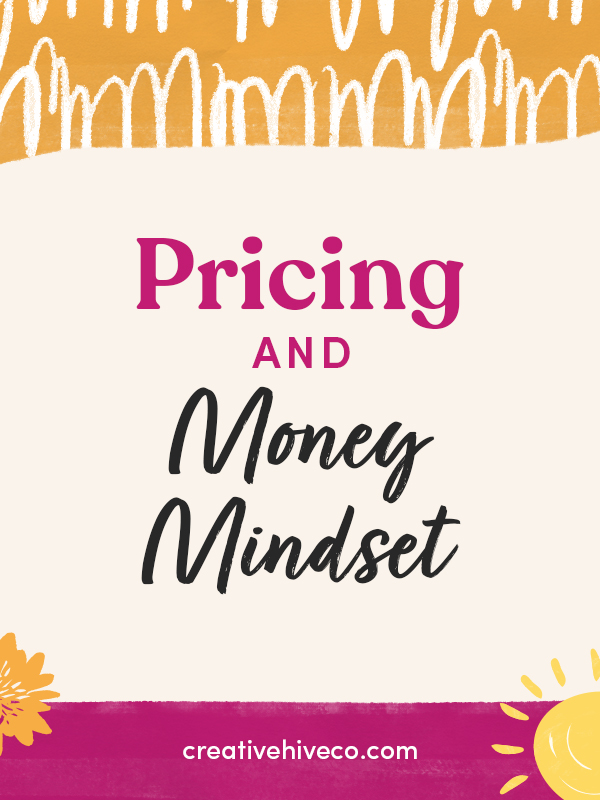I want to help you build a sustainable, profitable handmade business that makes you consistent income and sales. I only ever teach or recommend marketing, social media, pricing, production and branding tips that I’ve personally used successfully in my own 7-figure handmade businesses.
I'm Mei, from Los Angeles!
Read More
Popular Posts You'll Love
Looking for something?
Categories
starting a business
get more traffic
running a business
make more sales
branding
growing a business
mindset & productivity
podcasts
pricing & money
product photography
reviews
selling on etsy
selling on amazon
social media
selling wholesale
- Facebook0
- Twitter13
- Pinterest0
- 13shares
As a business owner, pricing your products is a crucial decision. It affects your business almost in every way. Are you ready to start getting paid more for your work? Read this article.
The way we think about money and how we price our products is easily one of the most complicated parts of starting and growing a business.
Some of you may not even want to face the truth that a huge part of your success is hinged on your mindset, because it’s scary to think the only thing getting in your own way is yourself, right?
You can’t blame anyone else anymore.
I’ve been there myself and it’s an ongoing journey, and I’ve learned over the years how important it is to address your money mindset if you want to build the business of your dreams.
The moment I realized how much value I bring to people through my products, my business reached a whole new level, and I want to share some ways that I shifted my money mindset to get to that point.
How to price your products?
In today’s article, I want to talk about a topic that can make a lot of us creative business owners a little uncomfortable, and that is the mindset we have when it comes to money and pricing our products. In this article, we’ll explore how to price your products
You may or may not realize this already, but we all have our own unique relationships with money.
Yes, you can have a relationship with an inanimate object.
You have certain feelings around money, and this is all stemmed from your childhood.
Maybe you were raised to think that money is the root of all evil.
That rich people were bad people.
Or more money, more problems.
I’ve talked to many people who don’t like money.
You know what happens if you don’t like money?
Money doesn’t like you.
It’s not your fault if you think this way, and it’s not your parents’ fault either.
I have to say though, Hollywood doesn’t help because they’re always villainizing rich people.
Anyway, my point is, once you start to see that how much money you make is directly related to how you feel about money, everything will change for you.
So let’s start with tip number one:
How to Price an Item
A lot of us are used to thinking of pricing in terms of time exchanged for money.
But my advice to you is to start basing your prices on the value your products bring to your customers, rather than how long it took you to make it.
Think of things in your very own life that bring you value.
Things like your microwave, refrigerator, car, and cell phone are all things that make your life easier, more comfortable, and convenient.
Imagine what your daily life would be like without those things, and ask yourself how much you’d be willing to pay to have them in your life.
Chances are you’d happily pay for them, even if they are expensive.
And you know most of these things are made in China for pennies to the dollar.
It’s not about time spent making the item.
It’s about the value it brings to people.
Use this same mindset when you price your own products.
But I know this can be tricky for some of us because we’re thinking our products don’t give people that much value.
Well, if you’re thinking that, just know that’s got something to do with your self esteem as well, and once you feel confident about your work, it will be easier to see the value your work brings.
Let’s move on to tip number two.
Price What You’re Worth
I’m sure we’ve all been told to “price what you’re worth.”
But how exactly do we measure worth?
Well, we’re told that we measure our worth by taking into consideration our experience or even educational history.
This concept works in the corporate world, and maybe to a certain degree in the fine art world.
But essentially by this logic, if you didn’t go to college, you’re “supposed” to have low prices, even if you’re crazy good at what you do.
Does that sound fair? I don’t think it is.
This type of advice is a trap that makes you attach your worth by society’s standards to your price.
On the other extreme, I’ve seen people charge exorbitant prices for accessible commodities that are pretty low in value.
There are coaches out there who tell their clients to charge a lot so you attract an affluent audience and get paid more while working less, and because you’re worth everything.
It sounds like a nice fairytale and yes, a lot of that’s true but out of context.
Your educational history can for sure help you in creating an amazing product, but unfortunately in this online business space, your masters degree alone is not something most people will find important.
It’s about how you use that masters degree to create something people care about.
So your history alone does not affect how you choose to price your products today.
Again, charge based on the value you bring.
Now onto tip number three.
Confidence
When it comes to pricing, confidence plays a huge role.
In fact, they go hand in hand.
Pricing too low is an indication that you’re not confident in yourself or the value that your products bring, and potential customers (at least ones that are really looking for quality) can pick up on that.
The truth is, you can price as high as you want or feel is fair, regardless of whether or not your competition prices as high as you.
The key here is to justify your prices to your customers, and you can do that by providing proof through fantastic photos, 5-star customer reviews, a great website experience, top-notch customer service, and quality packaging.
Providing these important details shows potential customers that you’re the real deal, giving you several opportunities to gain their trust, and giving them several reasons to see the value you do actually bring.
Don’t just charge higher prices because YOU know your products are amazing, and then expect your products to do the selling themselves.
Your customers don’t know your product is amazing, you have to show them.
Now with that said, I can still totally understand how nerve-racking pricing can be when you’re first starting out and you’re looking for your first customers.
Charge Lower Rates At First
For that reason, tip number four is to charge lower rates, only at first, as you establish yourself and gather positive customer feedback along the way.
This can help you gain confidence as you begin seeing more and more customers loving your products.
It’s a cycle right?
The first sale is always the hardest to get, but once you get it, you get a little confidence boost.
When you make another sale, you get another confidence boost.
The important thing here though, is to not stay at those low rates forever.
Gradually raise your rates over time the more confident you get, until you’re charging what you actually want to charge.
Starting at a lower, more competitive price in the beginning can be a great strategy for penetrating a saturated market.
But pricing low isn’t sustainable for most of us in the long run, so let’s aim to get those prices up over time.
Pricing is Not Set In Stone
BONUS TIP: Pricing is not set in stone!
Despite what your brain or what other people might tell you, you can change it.
You are the boss of your business, if you’re getting flooded with orders, raise your prices.
If you’re not getting enough orders, lower your prices.
It’s a fundamental economic principle of supply and demand.
I know there is fear surrounding changing up your prices, and we make it out to be harder than it really is.
So my question to you is:
What if it were easy?
How can you make it easy?
We do this all the time in my husband’s print on demand art shop business, which made a million dollars last year, by the way.
And if you’re curious to learn more about how we did that, there’s a free workshop you can sign up for, so be sure to check that out!
Mindset
Tip number five really focuses on mindset.
Like anything in life, having the right mindset for the given situation is key to moving forward.
So let’s assess your money mindset with a simple starting question:
Do you ever get upset when people sell to you?
If your answer is yes, then let’s work on changing that mindset, because if you don’t like it when others sell to you, it’s very likely that you’ll have a hard time selling to others.
Let’s figure out a way for you to associate selling with something positive.
A great place to start is to think about the times that you were sold something that you really loved, something that brought some sort of value to your life.
Think of that process from A to Z.
How did you end up purchasing that product that you love so much?
At some point, someone had to have sold you on it, resulting in a good outcome.
Embracing a selling (and being sold to) mindset will change everything for the better.
The fact that you bought a certain product suggests that you had a positive selling experience, so apply key points from your experience into your own business to make a positive experience for your customers too.
The more you can rework your negative money stories into positive ones, the more money you’ll make.
I know it sounds woo woo, and I didn’t believe in that stuff when I was younger, but I can tell you now after having made millions of dollars with my online businesses, that it’s so true.
Regardless of all of that, though, it’s still easy to become overrun by fear sometimes.
You might be fearful that pretty much every customer will think your prices are too high, resulting in little to no orders, which means that your business isn’t growing, which then leads to financial fears and feelings of failure.
Wow, that was a mouthful, wasn’t it?
But that’s literally how our thought process can go.
We naturally tend to think of the worst-case scenario, and all of that is brought on by our own fears, which is a basic survival instinct.
Get Comfortable With Your Fears
That’s why the sixth tip is to get comfortable with your fears.
How?
By developing a different perspective.
Think of it this way: sure, maybe you’ll miss out on some customers, but for every customer who isn’t willing to pay your price, there’s a customer who is.
Think about all the time, effort, and resources that go into making your handmade products.
By accepting a price way lower than the value that your products give, you create more work for yourself without the adequate pay in return.
So try your best to adopt this mindset: the customer who won’t end up buying your product simply just makes room for the customer who will, because they want high-quality and value.
Those are the types of customers you want to build up over time, the ones who understand that you get what you pay for, and that quality items are going to have higher prices.
Sustainability
Our seventh tip is sustainability.
Imagine a scenario where you underprice your products.
While this could potentially mean that you’ll have more orders coming in, that would also mean having to fill those orders more frequently.
This could end up making you stressed and pressed for time, and not to mention having to buy more supplies (with a lower profit margin).
That’s not sustainable.
You can’t do that forever and you’ll for sure get burned out.
Now imagine a scenario where you price your products for the value they bring.
Sure, maybe you’ll have less orders coming in since your prices are higher, but the beauty of this is that when just one person makes a purchase, the price of that one order would be the equivalent of, for example, three people purchasing the same product at a lower price.
This means that you won’t constantly be pressed for time having to fill orders and you can have more freedom in your day.
If you found this article helpful, or if you have your own money mindset story in your business, let us know in the comments below.
And don’t forget to subscribe to my YouTube channel for more great handmade business tips and tricks!

Leave a Comment
Liked this article? Share it!
Unlock a Profitable Handmade Business
in Just 12 Weeks Without Using Etsy
or Social Media
FREE WORKSHOP
This workshop is for anyone who makes and sells a handmade or physical product, including jewelry designers, artists, paper designers, bath & body product makers and more!
What You'll Discover
The #1 mistake people make with Etsy & social media that causes shops to FLOP
The secret to making it with your handmade shop so it's no longer just a hobby
How to make sales in your handmade shop with ease so you can finally get to 6-figures
TAKE ME THERE
Your email address will not be published. Required fields are marked *
Leave a Reply Cancel reply
About
Blog
A Sale A Day
Student Login
Free Class
Contact
Terms
Become A Student
Watch On YouTube
Student Reviews
See My Handmade Shop!




Pricing is not set in stone… Great words! Who said that? 3 weeks ago I stumbled upon a very informative blog by Priceva. I find it really gorgeous even after 13 years of selling Apple products in a local mall in London. I wish I had known this information https://priceva.com/blog/price-skimming-strategy back in 2010 :)
Your blog expands my knowlege. Thanks and have a great day!
You are distributing a priceless resource without costing anything. Besides, I would recommend to everyone elastic man which is an exciting game.
Every move in four in a row is a test of precision and foresight. The careful placement of each disc can be the difference between victory and defeat, making this game a remarkable test of skill.
Your post highlights the importance of leveraging digital platforms to generate income. It’s a timely reminder that there are numerous opportunities available in the online space. To delve deeper, click here.